(April 10, 2025) From presenting research at global symposiums in California and Beijing to leading pioneering pigment studies using AI and spectroscopy, archaeologist and ethnographer Sachin Kumar Tiwary is carving a niche for India in the world of rock art research. His work connects ancient symbolism to modern science — and links India’s creative past to a global heritage conversation.
When Sachin Kumar Tiwary starts narrating some fascinating aspects about the creativity, artistic expressions and imaginative capabilities of the people who lived thousands of years ago — it calls for rapt attention. His knowledge comes from the extensive research he has done over the years, painstakingly going through the intricate designs, motifs and depictions found in rock art paintings across India.

A rock art painting of India
It is only when he lists out the commonalities between the Coso rock art of California, the Kosovo rock art in south-west Europe and rock art complexes of Northern Russia and Serbia with that of the intriguing rock art back home in India, that one underscores the significance of these creative endeavours in preserving and transmitting the cultural heritage across generations.
“In essence, rock art serves as a tangible testament to the ingenuity and creativity of past civilizations, offering a window into their worldviews, beliefs, and artistic traditions,” smiles Sachin Kumar Tiwary, in a chat with Global Indian.
Presently working as Assistant Professor in the Department of Ancient Indian History, Culture and Archaeology at Banaras Hindu University in Varanasi, Sachin has done some pathbreaking work in the field of ancient rock art. While he has presented his research work and findings at symposiums held worldwide, including the US, Germany, Seoul and Beijing, his papers have been published across several international journals. His most recent work in the Kaimur region in Uttar Pradesh has unearthed some interesting aspects of rock art in India.
Pregnancy and animals: Thematic linkages
What is common between rock art found in California, South-West Europe, Northern Russia, Serbia and India?
“Pregnant women and animals have frequently been depicted in rock art in these countries. The scenes in rock art have been considered to be a symbol of fertility and reproduction, globally,” says Sachin.
In the Indian context, most rock art complexes have a hunting scene. “Yet, one comes across many examples of human pregnancy and delivery scenes. Some have been depicted with groups of humans, some with animals, and some alone,” says Sachin, whose paper was published in the Peruvian newsletter Boletin Apar.
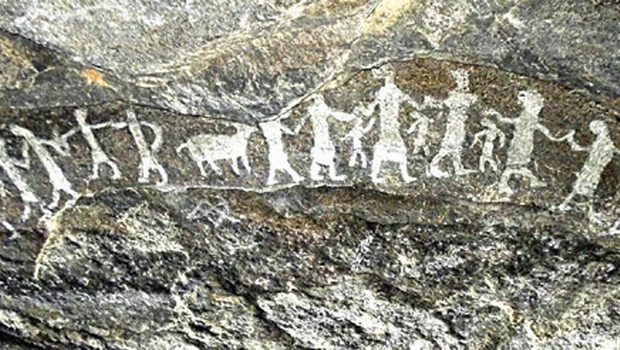
A rock art painting of India
Filled pots on the heads of pregnant women is also a common thing in some pregnancy scenes.
“Childbirth and pregnancy scenes, whether involving humans or animals, transcend mere artistic expression. They serve as windows into the values, rituals, and societal priorities of bygone eras,” adds Sachin, who worked as Assistant Archaeologist and Deputy Superintending Archaeologist in Archaeological Survey of India between 2009–2016.
In the Coso rock art of California, pregnant women and animals are frequently depicted along with bighorn sheep while the Kosovo rock art depicts sexual symbols. Similarly, the rock art complexes of Northern Russia and Serbia have several pictures of a pregnant woman near a deer or reindeer.
Deity and women
The depiction of pregnant and delivering mothers in rock art can be classified into two kinds of expression; one depicting the fertility power of woman as a deity and the other playing a part in the social structure.
“We don’t have any scientific date for these mother figures in rock art but most of them belong to Agro-pastoral communities that means Neolithic and Chalcolithic periods and a few of them belong to the historic periods,” says Sachin, who presented a paper on “Depiction of Buddhist theme in the Indian Rock Art” at a workshop organised by The J. Paul Getty Trust and the Ministry of Culture in Los Angeles.
The women are sometimes shown with divine features like a hollow behind the head as seen in the Trans-Himalayan region — a developed form of goddess iconography.
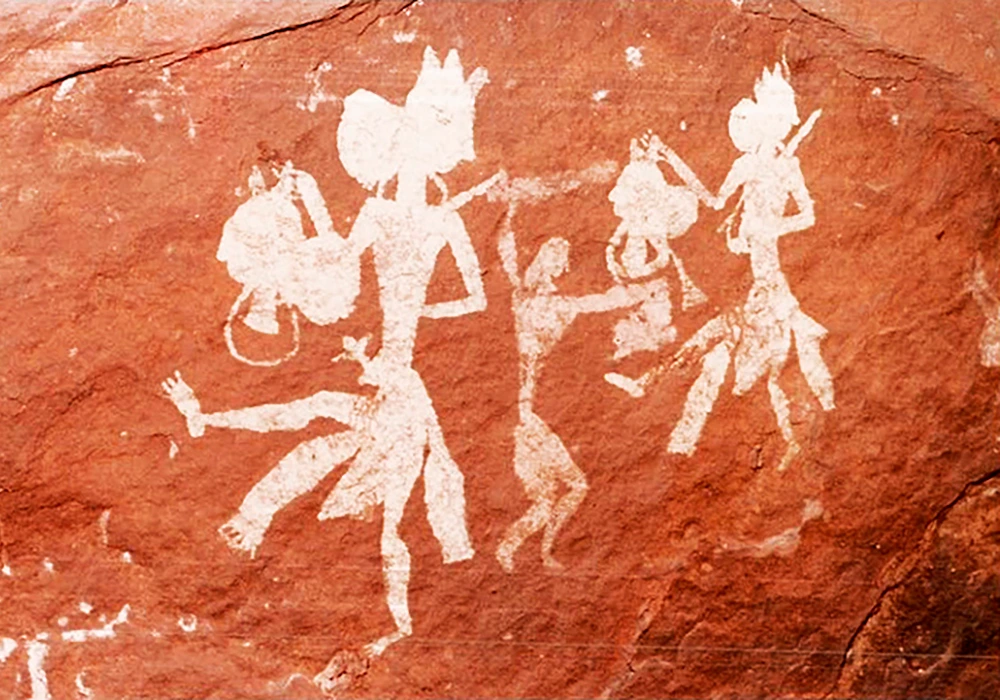
Pre-historic rock art of Panchmarhi Hills
“Similar concepts of mother and children are seen in central India at many places, which shows a shared iconography and ideology among these folks who depicted such figures on rock,” he notes.
He adds that perhaps the concept of the divine mother originated as an archetype symbol in different groups located far from one another — or it would have been an easy-to-adopt symbol for people across regions, from forests to the cold deserts of the Himalayas. Sachin is also a member of the International Cultural and Creative Industries Regulatory Authority, Brussels.
Bhimbetka and Panchmarhi
In some human pregnancy and delivery scenes, the presence of animals is notable, and sometimes humans are featured in scenes primarily showcasing animals.
“It appears that both are dominating in the scene, making it difficult to view anyone as the focus,” he says, pointing at a painting from Bhimbetka wherein a pregnant woman is depicted in front of a pregnant cow, and the woman is pointing to the cow.
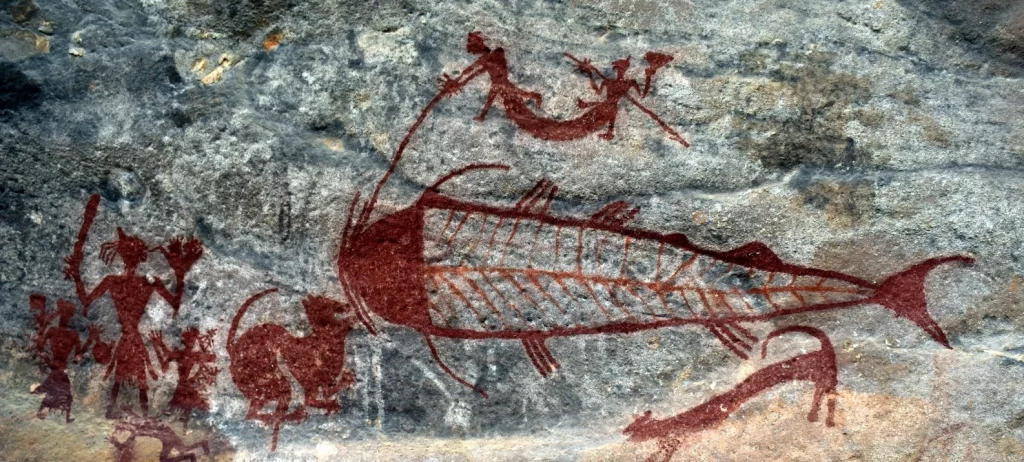
A rock art in India
Similarly, in the depiction of Mahadev cave in Pachmarhi, the two pregnant women following a horse are shown holding hands. “One woman is holding the tail or indicating towards the hind portion of the horse. It seems that all are running in the right direction,” notes the rock art expert, who presented one his findings at the College of Inner Mongolia University, Beijing.
The great discovery
The discovery and publication of the first rock art site in the world was in Brazil in 1618, followed by Australia in 1788. In India, rock art was first discovered by Archibald Carlleyle of the Archaeological Survey of India in 1867 in the sandstone hills of Sohagighat in the Vindhyas (Mirzapur, Uttar Pradesh).
India is one of the three countries with the largest concentration of the world heritage of rock art — the other two being Australia and South Africa.
Sachin Tiwary
India is home to over 1,500 rock art sites spread across the country, dating from the Upper Paleolithic period to more recent times. The most renowned among them is the Bhimbetka rock shelters in Madhya Pradesh, a UNESCO World Heritage Site with paintings over 30,000 years old. These ancient artworks, found in regions like Central India, Chhattisgarh, Uttar Pradesh, Karnataka, Andhra Pradesh, and Ladakh, reflect the rich diversity of India’s prehistoric and tribal cultures.
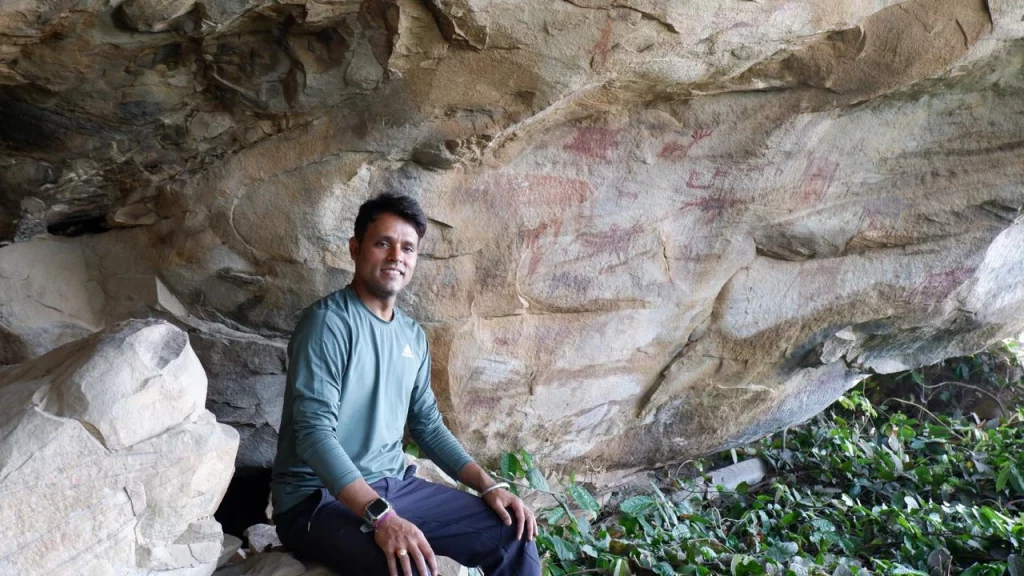
Sachin Kumar Tiwary
The Kaimur breakthrough
Among Sachin’s recent works is extensive research in the Kaimur range in Sonbhadra, Uttar Pradesh. Having worked on it for the last 14 years, Sachin, in association with experts from IIT Bhilai and IIT-BHU, carried out the most detailed analysis of pigments for their chemical structure and types of binders (natural and artificial) used in Indian rock art painting. They used AI-based imaging to identify correlations with other comparable paintings.
“We introduced novel methods of non-destructive techniques like handheld XRF, SEM, Fourier Transform Infrared Spectroscopy and Raman Spectroscopy for studying pigment composition and surface characteristics,” says Sachin.
Two significant findings emerged – firstly, laterite was also used as a red pigment source, alongside haemetite, and safflower was identified as a medium of pigment, with evidence from the Chalcolithic site of Lahuradeva in Sant Kabir Nagar, UP.
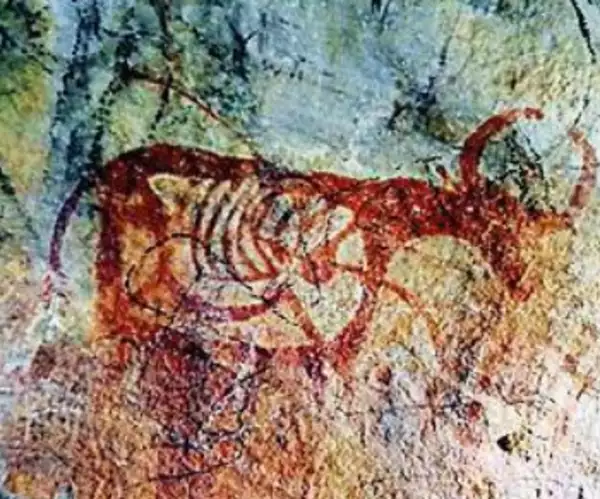
A rock art at the Kaimur Range
The findings prove that our ancestors were smart enough to look out for new techniques to express their feelings through rock art.
Sachin Tiwary
The team dated the rock art of this region from the Mesolithic (about 8000 years ago) to the present, using iconography, superimposition, scenes and artefacts from the shelters and their surroundings.
Ethno-rock art and continuity
In his research on Ethno-rock Art, Sachin stresses the importance of connecting rock art to the customs, beliefs, and practices of local communities.
“Ethno-rock Art includes everything constructed by our ancestors to their predecessors. It tries to interpret and understand rock art by establishing its linkages with the ethnic group, folklores, myths, beliefs, customs, rituals and their cultural practices,” he says.
He contrasts India’s fragmented rock art continuity with the Bushman Tribe of Africa or Dreamtime rock art of Australia.
“We, like them, can know the continuity of rock art, provided we know who the original inhabitants of the place were, where are they now, and under what circumstances was their migration,” says Sachin, adding that India’s long history of invasions disrupted this continuity.
He points out the danger of ignoring symbolic interpretation: “If we know the meaning of any symbol or scene, it is not necessary that we get the same meaning in all contexts.”
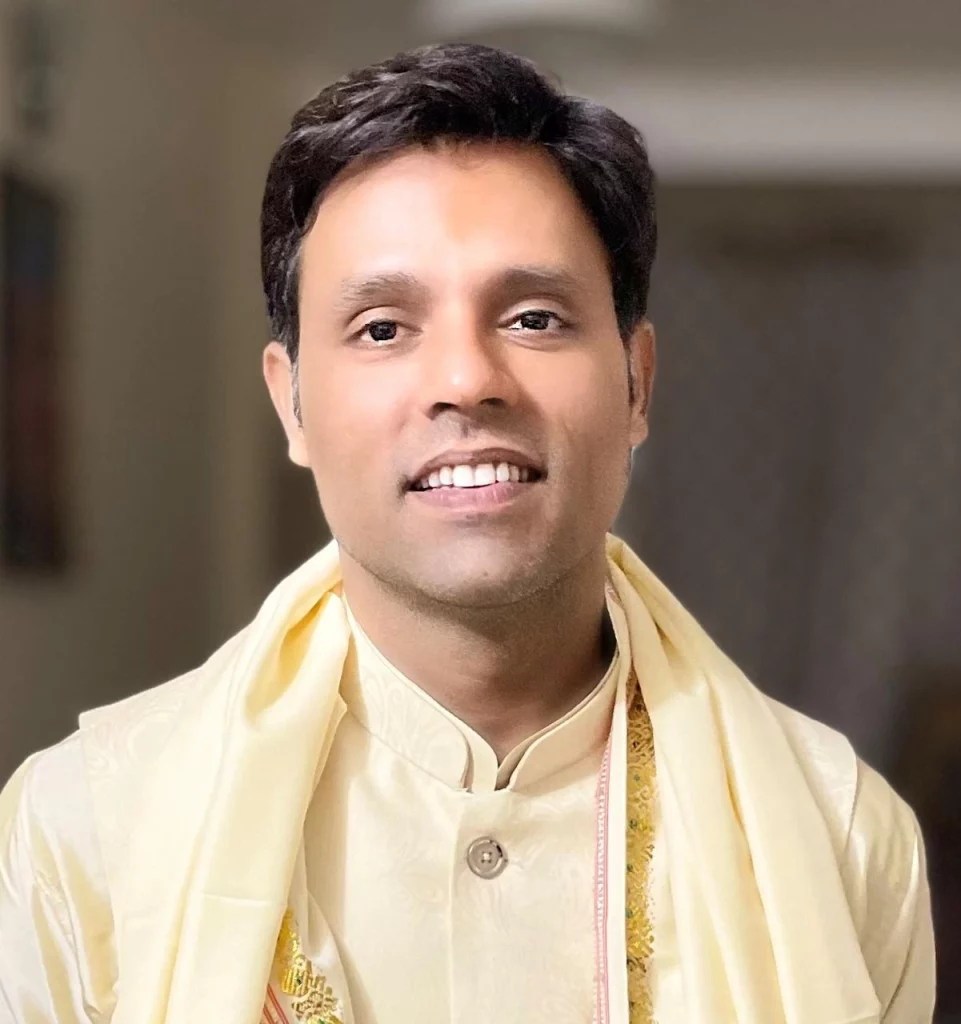
Sachin Kumar Tiwary
A voice from Jharkhand: Bridging rock art and reserch
Born in Chaibasa, Singhbhum district of Jharkhand, Sachin had a passion for archaeology since college. He completed his graduation and post-graduation from BHU, a PG Diploma in Archaeology from the Institute of Archaeology, and a PhD on “Rock Art of Kaimur Region (Bihar)” from Patna University.
Sachin recently co-authored a book titled “Understanding Rock Art Heritage: A Primer on Interdisciplinary Scientific Approaches,” a culmination of a project funded by the IKS Division, Ministry of Education. “It’s not just a primer, it’s a roadmap for future research,” he says.
The book advocates combining scientific methodologies with traditional knowledge and includes detailed documentation sheets and examples, making it an indispensable resource.
“It emphasizes the crucial role of preserving the global civilizational heritage for future generations,” he signs off.


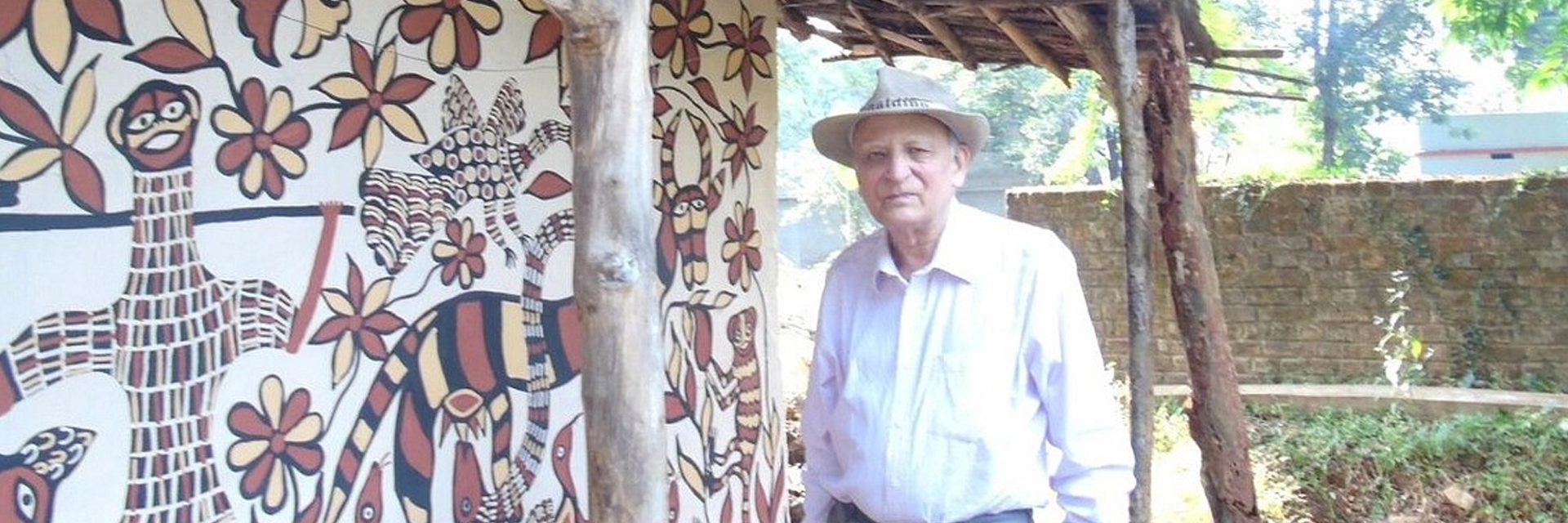


Absolutely groundbreaking work by Dr. Sachin Tiwari! His interdisciplinary approach—blending AI, spectroscopy, and ethnography—is revolutionizing how we understand India’s rock art heritage. The global parallels he’s drawing prove art transcends borders.
Proud to see Indian research leading the way! Good Luck to Dr. Tiwari.
He is my friend and i know him since 2000, a truly mad man for field work and archaeology, all the time for trecking and mountaneering. Sachin’s research exemplifies the power of merging traditional archaeology with cutting-edge science. His pigment studies in Kaimur set a new benchmark for non-destructive analysis.
Being a relative of Dr. Sachin ji, i can understand his deep passion and dedication towards archaeological research as his first wife. Was not aware about this coverage since he is very reserve person. Today only we family members and friends came to know about this. The ethno-rock art continuity perspective is particularly compelling-highlighting how invasions disrupted India’s narrative threads. A masterclass in interdisciplinary scholarship! Proud to Dr. Sachin!
Fascinating how Sachin ji works revealing universal themes-fertility symbols from around the world. His collaborative and friendly nature is truly commendable. Kudos to Dr. Sachin ji. Our youngest D.Litt.
I am a Biology student. And had absolutely no interest in history.
This is the first time I read something so interesting related to our human history.
I didn’t expect to know that earlier humans used to communicate using animal drawings and such. And whats fascinating is that, somehow humans from different parts of the world somehow ended up using the same animals to signify the same things.
And the idea of a ‘God’ being present,even so back in the day.
It might be just me lacking any idea on this subject but can’t say I have seen these important and interesting parts of our history properly shown and told to people.
We really need to spread awareness on this, So people can know that history wasn’t just about those boring wars and ruler’s whose names and time frame we had to learn just to put it in a sheet of paper and be done with it.